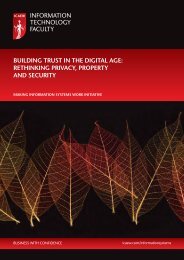Security Effectiveness Framework Study
Security Effectiveness Framework Study
Security Effectiveness Framework Study
You also want an ePaper? Increase the reach of your titles
YUMPU automatically turns print PDFs into web optimized ePapers that Google loves.
<strong>Security</strong> <strong>Effectiveness</strong> <strong>Framework</strong> study<br />
<strong>Study</strong> methods<br />
Ponemon Institute has independently completed a study<br />
that focused on operational effectiveness in the information<br />
security environment for a sample of 101 UK and<br />
European companies. Participants in this study are all<br />
highly-experienced information security leaders, including<br />
those holding the CISO title. The purpose of this research<br />
was to develop and empirically validate the <strong>Security</strong> <strong>Effectiveness</strong><br />
<strong>Framework</strong> in terms of key variables and output<br />
metrics defined in Figure 1.<br />
As Pie Chart 1 shows, respondents from 14 different<br />
industry sectors are represented in this study. The largest<br />
segments include industrial (18 percent), financial services<br />
(15 percent) and public sector (14 percent).<br />
Approximately 80 percent of respondents are located in<br />
the United Kingdom. About twelve percent are located<br />
in Germany, four percent located in France and three<br />
percent located in the Netherlands.<br />
Pie Chart 1: Respondent organisations’ industry classification<br />
6%<br />
8%<br />
5%<br />
3%<br />
4%<br />
10%<br />
10%<br />
2%<br />
18%<br />
14%<br />
15%<br />
Industrial<br />
Public sector<br />
Retail<br />
Services<br />
Hotels<br />
Defense<br />
Media<br />
Financial services<br />
Health & pharma<br />
Technology & Software<br />
Transportation<br />
Communications<br />
Education<br />
Energy<br />
Most respondents were employed by organisations with<br />
a headcount of 1,000 or more full time employees. Thirtynine<br />
percent worked for larger-sized companies with more<br />
than 5,000 employees. About 12 percent of respondents<br />
define themselves as senior-level executives. Fifty-five<br />
percent are directors and 23 percent are managers.<br />
Caveats<br />
The study utilised a diagnostic interview method that has<br />
been successfully deployed in earlier research. However,<br />
there are inherent limitations to this type of research that<br />
need to be carefully considered before drawing conclusions<br />
from these findings.<br />
Non-statistical sample:<br />
The purpose of this study is descriptive inquiry rather than<br />
normative inference. This research draws upon a representative,<br />
but non-statistical sample of highly-experienced IT and<br />
IT security practitioners.<br />
Non-response:<br />
The current findings are based on a small representative<br />
sample of companies. An initial invitation was sent to targeted<br />
individuals in more than 500 organisations. One hundred and<br />
one individuals agreed to participate. Non-response bias<br />
was not tested so it is always possible companies that did<br />
not participate are substantially different on key aspects of<br />
security effectiveness.<br />
Sampling-frame bias:<br />
Because the sampling frame is judgmental, the quality of<br />
results is influenced by the degree to which the frame is representative<br />
of the population of companies being studied. It<br />
is Ponemon Institute’s belief that the current sampling frame<br />
is biased toward companies with more mature data protection<br />
and information security programmes.<br />
Unmeasured factors:<br />
To keep the survey concise and focused, Ponemon Institute<br />
decided to omit other important variables from the analysis<br />
such as leading trends and organisational characteristics.<br />
The extent to which omitted variables might explain study<br />
results cannot be estimated at this time.<br />
Sponsored by: HP Information <strong>Security</strong> and Check Point Software Technologies Ltd.<br />
Ponemon Institute © Research Report & InstrumentPonemon Institute © Research Report & Instrument<br />
13



